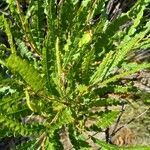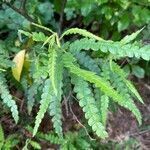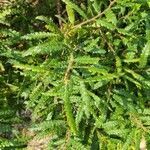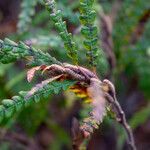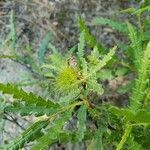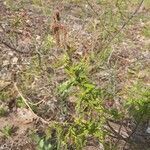Shrubs , to 1.5 m, forming rhizomatous colonies. Branchlets red-brown to gray, pilose to villose, sometimes puberulent. Leaves: stipules nearly cordate, long-acuminate. Leaf blade very aromatic when crushed, 3-15.5 × 0.3-2.9 cm, lobes alternate to nearly opposite, base truncate, cuneate to attenuate, or oblique, apex acute; surfaces abaxially pale gray-green, densely pilose to puberulent, adaxially dark green, densely pilose to glabrate, gland-dotted, especially adaxially. Inflorescences: staminate in clusters at ends of branches, elongating to 5 cm, bracts broadly ovate to trullate, margins ciliate, apex acute to long-acuminate, abaxially gland-dotted; pistillate to 5 mm at anthesis, elongating in fruit to 2 cm, bracteoles to 1.3 cm, pilose, gland-dotted. Fruits 2.5-5.5 mm.
More
A small suckering shrub. It loses its leaves during the year. It develops many stems. It grows 1.5 m high and spreads 2.4 m wide. It has feather like leaves which have lobes. The leaves are 5-10 cm long and the lobes are deep. The male and female flowers are on separate catkins. The male ones are slightly longer. They are red-brown. The female catkins enlarge as the seed ripens.
It is a temperate plant. It grows in fields and woodlands. It does best in moist, well-drained soil. It should be rich in humus and slightly acid. It can grow in full sun of light shade. It suits hardiness zones 4-9.
More
Dry, sterile, sandy to rocky soils in pinelands or pine barrens, clearings, pastures or edges of woodlots from sea level to 1800 metres.
